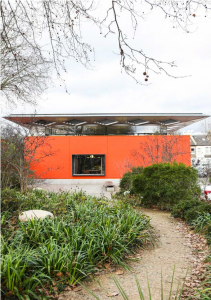Maggie’s sits outside and inside the hospital. The building – ‘a tangerine puzzle’ – is connected to the hospital yet stands apart, visibly different. Maggie’s respects hospital protocol but also has its own rules and ethos. Maggie’s Centres are designed by internationally renowned architects, in accordance with guidelines about ‘healing architecture’. Several participants referred to Maggie’s as ‘a second home’ and Charles Jencks apparently coined the term ‘kitchenism’ for a key element to the design that enables patients and carers to come and go when they wish and simply gather around the kitchen table for a cup of tea in a proper mug rather than a hospital-issued plastic cup. See The Architecture of Hope: Maggie’s Caring Cancer Centres eds. Charles Jencks and Edwin Heathcote (2015 [2010]). Maggie’s regulars were sometimes reluctant to leave at the end of the day, even though Maggie’s staff are very clear on boundaries (see The Man From Cavan).
On the roof you are both inside and outside the building and downstairs where people sit, there is also an inside/outside space. Inside/outside is a recurring motif that explores the sense of standing on some kind of threshold which may evoke feelings of separation or not-belonging. Di, afraid she might be mistaken for someone living with cancer (and therefore behaving like an imposter) was stuck at the door, not knowing how to act in this situation nor amongst these people. Sophie described similar feelings. Volunteers likewise allow the outside in without quite knowing what might be arriving since, at Maggie’s, volition applies to both sides of a transaction. There’s a sense of coming and going freely that begins with finding your way into the building, when and how you please. The idea that you have to find your own way onto the one path shared by all is another recurring motif. This was illustrated on a mundane level by the writer failing to get into the building until she discovered what to others would appear the obvious – and only available – path.
This first visit was in mid-April 2019 and the sky very changeable, which seemed to reflect life at Maggie’s where people and things are in constant flux, reconfiguring and adapting to circumstance (see Knights of the Oblong Table). Round the kitchen table a vigorous discussion of Brexit was going on.

In the precinct of the Hospital
outside its jurisdiction
an Orange Box –
tangerine puzzle between worlds
roof in flight
entrance hidden
like something from the pages of Ruiz Zafon
or Harry Potter –
visible
when you know where to look.
The visible and the invisible,
the in and the out,
is at the heart of this place.
We come and we go.
Lost on the outside
I am lost on the inside.
A moment of suspension,
rush of anonymity.
I could be anyone
feel the need to identify myself
despite the open door,
look for a gatekeeper.
A woman volunteers a smile.
The Box unfolds
an origami of light.
The fickle Spring sky is everywhere.
Rainbows glimmer on wood
as the busy kettle serves
the Kitchen Table –
the hub, nub, agora
where keen minds and long memories
dissect the latest bulletins
from the ruinous body politic.
Away from the Table
quiet spaces offer themselves
or hide round corners,
hearth and book
flower and stone
home and not home.
A stairway points skyward
self-evident
as a ladder in a children’s game
or Jacob’s dream.
Up here, the Team
keep the architectural starship
live on the radar.
The roof beckons –
sun and shade in equal measure,
tree and bird
reaching, curling, swooping,
the leafing of the vine
a promise in the making.